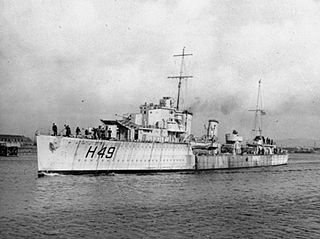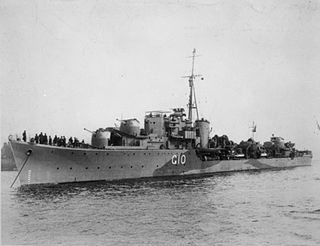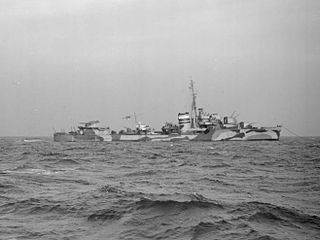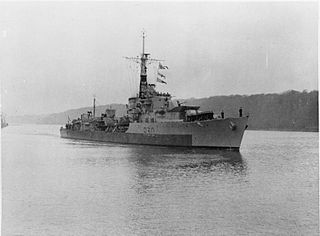
HMS Imperial was one of nine I-class destroyers built for the Royal Navy during the 1930s. She was scuttled by HMS Hotspur in 1941 after she had been crippled by Italian bombers.

HMS Inconstant was an I-class destroyer built for the Turkish Navy, but was purchased by the Royal Navy in 1939.

HMS Kandahar (F28) was a K-class destroyer built for the Royal Navy during the 1930s, named after the Afghan city of Kandahar.

ORP Orkan, formerly HMS Myrmidon, was an M-class destroyer of the Polish Navy during World War II. Orkan is Polish for "hurricane".

HMS Raider was a R-class destroyer built for the Royal Navy during the Second World War.

HMS Penn was a P-class destroyer built for the Royal Navy during the Second World War.

HNoMS Stord was a Royal Norwegian Navy destroyer during the Second World War. She was built for the Royal Navy as the S-class destroyer HMS Success, but was transferred prior to completion in 1943 to the Norwegian Armed Forces in exile. Stord survived the war and remained in service with the RNN until 1959.

HMS Ulster was a U-class destroyer of the Royal Navy of the United Kingdom that saw service during World War II. She was later converted into a Type 15 fast anti-submarine frigate, with the new pennant number F83. Ulster was the second vessel in Royal Navy history to have that name.

HMS Terpsichore was a T-class destroyer built for the Royal Navy during the Second World War.

HMS Tyrian was a S-class destroyer built for the Royal Navy during the Second World War.

HNoMS Svenner was a Royal Norwegian Navy destroyer during the Second World War. She was built for the Royal Navy as the S-class destroyer HMS Shark but on completion was lent to the Norwegian Armed Forces in exile. Svenner was sunk off Sword, one of the Allied landing zones in Normandy, at dawn on 6 June 1944 while supporting the British Army Normandy landings. It was the only Allied ship to be sunk by the Kriegsmarine during the morning of the invasion.

HMS Scourge was an S-class destroyer built for the Royal Navy during the Second World War. The ship was sold to the Netherlands postwar, where it saw action in the Korean War and the West New Guinea dispute.

HMS Racehorse was a R-class destroyer built for the Royal Navy during the Second World War.

HMS Redoubt was an R-class destroyer built for the Royal Navy during the Second World War.

HMS Pathfinder was a P-class destroyer built for the Royal Navy during the Second World War. She was damaged while serving in the Far East, and was scrapped after the end of the war.

HMS Milne was a M-class destroyer of the Royal Navy which served during World War II. She was equipped as a flotilla leader.

HMS Loyal was a L-class destroyer built for the Royal Navy in the late 1930s, although she was not completed until after World War II had begun.

HMS Carron was one of thirty-two C-class destroyers built for the Royal Navy during the Second World War, a member of the eight-ship Ca sub-class. Commissioned in late 1944, she was assigned to the Home Fleet and escorted the fleet's larger ships during operations off German-occupied Norway. Carron was sold for scrap in 1967.

HMS Cavendish was one of eight C-class destroyers built for the Royal Navy during the Second World War. Commissioned in late 1944, she was built as a flotilla leader with additional accommodation for staff officers. The ship was assigned to the Home Fleet in 1945 after working up where she escorted capital ships of the fleet. Cavendish was sold for scrap in 1967.

HMS Caesar was one of thirty-two C-class destroyers built for the Royal Navy during the Second World War, a member of the eight-ship Ca sub-class. Commissioned in 1944, she was built as a flotilla leader with additional accommodation for staff officers. The ship was assigned to Home Fleet during 1944–1945 and escorted one Arctic convoy as well as the capital ships of the fleet.




















